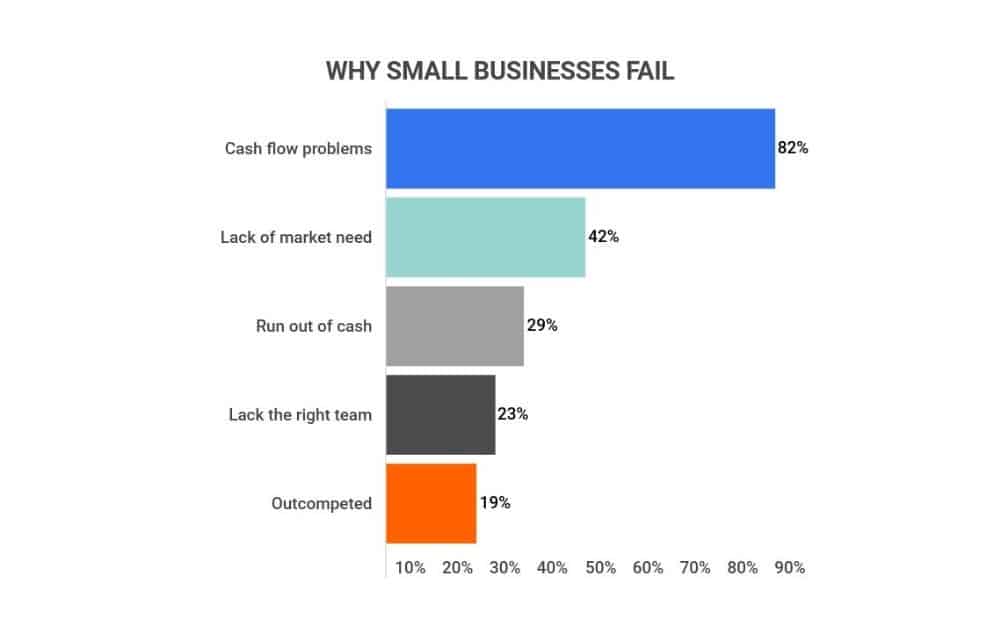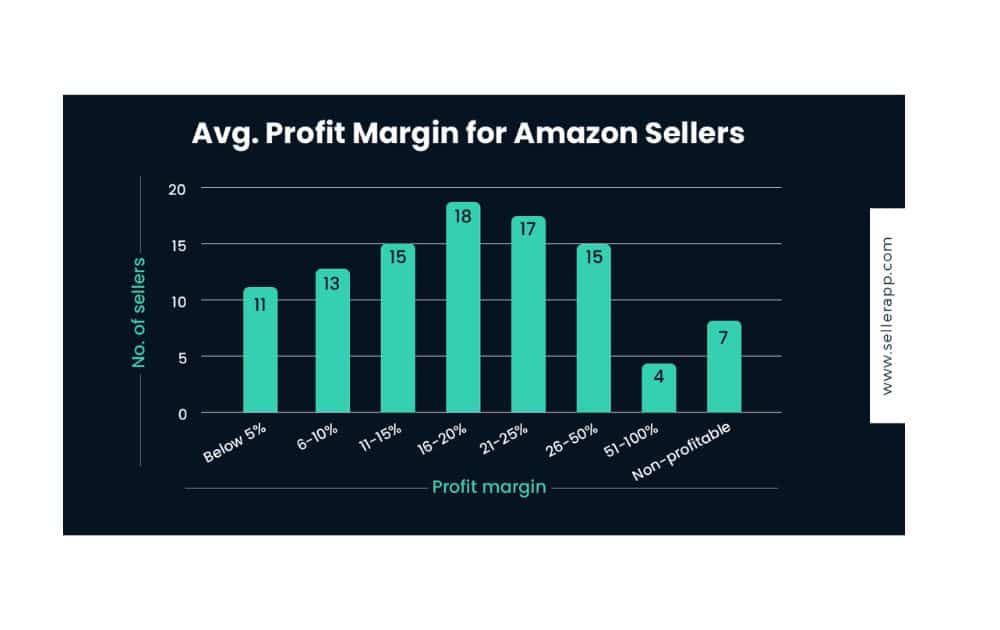If you haven’t been keeping tabs on your Amazon profit margin, here’s something that might shake you up and convince you to keep a closer eye on your finances. Data cited by Zippia reveals eight out of 10 businesses fail due to cash flow problems.

Without knowing how much your Amazon profit margin should be and comparing it with how much you’re actually earning, it would be hard to make informed decisions about your business and strategize properly.
Below, we offer a step-by-step guide on how to calculate yours. We’ll also give you a few tips to grow your Amazon store’s cash flow and answer a few frequently asked questions about the matter.
What is Amazon Profit Margin?
First off, what is Amazon profit margin? How does it differ from terms such as “Amazon gross profit margin” and “Amazon net profit margin”?
Amazon Profit Margin
An Amazon seller profit margin is a broad term that encapsulates the profitability of selling products on Amazon. It’s the percentage of revenue that remains after all costs have been subtracted from the total sales.
Amazon Gross Profit Margin
This initial level of profitability measures the difference between sales and the cost of goods sold (COGS) without accounting for other operating expenses. The Amazon gross profit margin offers a glimpse into the effectiveness of your product pricing and direct cost management.
Amazon Net Profit Margin
Taking a step further, the Amazon net profit margin subtracts all operating expenses, taxes, interest, and additional costs from the gross profit.
This metric provides a comprehensive view of your business’s financial health, revealing the percentage of revenue that ultimately constitutes your profit.
ROI (Return on Investment)
A critical measure for any business venture, ROI calculates the efficiency and profitability of your investments, allowing you to assess the gains relative to the costs involved.
- Formula: (Gain from Investment−Cost of Investment)/Cost of Investment × 100
Why You Need to Calculate Your Amazon Profit Margin
Here are a few reasons why understanding and calculating your Amazon profit margin is not just beneficial but essential.
Guiding Financial Health and Decision Making
At its core, your Amazon profit margin tells you whether you’re actually making money after all expenses are accounted for. It’s the clear line separating profitability from loss, guiding you in areas like:
- Pricing products
- Managing costs
- Financing options
- Evaluating the financial health of the business
Without this insight, you’re essentially operating in the dark, risking decisions that could harm your business’s viability.
Investment and Growth Opportunities
Calculating your Amazon profit margin is crucial when considering reinvesting profits back into your business. A healthy profit margin not only demonstrates the potential for sustainable growth but also provides the funds necessary to grow your business further.
For instance, online incubator and accelerator FasterCapital cited several ways to reinvest profit. Some include research and development, new market expansion, tech upgrades, marketing and advertising, acquisitions and partnerships, and employee development.

This metric helps you allocate resources efficiently, ensuring that investments are made in areas that will offer the highest return.
Benchmarking Success
Profit margins serve as a benchmark for success over time, allowing you to set financial goals and measure progress. By keeping tabs on your venture’s numbers, you can stay on top of areas, including sell-through rate, ROI, FBA refunds, and more.
They also enable you to compare your performance against competitors within the same category, giving you insight into your standing in the marketplace and areas for improvement.
How to Calculate Your Amazon Profit Margin
Step 1: Know Your Net Sales
Your total sales revenue is the sum of all income generated from Amazon sales before any expenses are deducted. On Amazon Seller Central, you can find this as Ordered Product Sales.

Step 2: Determine Cost of Goods Sold (COGS)
COGS includes the direct costs attributable to the production of the products sold. This can encompass areas such as:
- Material costs
- Direct labor
- Other direct costs involved in creating your product
Step 3: Account for Amazon Fees and Additional Operational Fees
Amazon charges various fees, depending on your selling plan and FBA fees, if you want to compute your Amazon FBA profit margin.
Amazon fees can include:
- Referral fees
- Closing fees
- FBA fees
Step 4: Calculate Your Amazon Gross Profit
To calculate your Amazon gross profit, follow this formula:
[(Total Sales Revenue-COGS) / Total Sales Revenue] x 100
For example, your total sales revenue for the month is $1,000, and your COGS is $400. That makes:
[(1,000-400)/1000] x 1,000 = 60%
Your Amazon gross profit margin is 60%.
Step 5: Calculate Your Net Profit
To calculate your Amazon net profit, apply this formula:
[Total Sales Revenue – (COGS + Amazon Fees + Taxes + Other Expenses)] /Total Sales Revenue x 100
Following the example above, with $1,000 total sales revenue and $400 COGS, let’s say you spent $100 on Amazon fees and $100 on taxes and other expenses. Computing these numbers, we get:
[(1,000-400-100-100)/1000] x 1,000 = 40%
Your Amazon net profit margin is 40%.
Gross Profit Margin vs. Net Profit Margin
What’s a better metric to use to guide business decisions – gross profit margin or net profit margin? The answer depends on what decision you’re making.
Gross profit margin shows how efficiently a business is producing or sourcing its products and how effectively it’s pricing them. A higher gross profit margin suggests that a company is able to sell its products at a price significantly higher than the cost of making them.
Net profit margin, on the other hand, is a critical indicator of a company’s financial health, including its efficiency in managing its expenses and overall profitability.
A higher net profit margin means a company retains more profit from each dollar of revenue, which is indicative of good financial health.
Online Profit Margin Calculators
If you don’t want to do manual calculations yourself, you can try using Amazon product profit margin calculator tools online.
Some of these tools are Amazon extensions, while others are simple tools that offer estimated projections of your margins based on your input.
Here are a few tools to check out:
- Revenue Calculator by Amazon Seller Central
- Sales Margin Calculator for Amazon by WebFX
- FBA calculator for Amazon Sellers by SellerApp
What is a Good Profit Margin for Amazon Sellers?
The average Amazon seller profit margin is around 15%–20%, and data from Sellerap reveals just as much.

Around 10% to 15% can be considered acceptable, and anything above 30% is deemed excellent.
However, it’s crucial to note that these figures can be quite flexible. After all, profitability on Amazon can be affected by various factors, including market segments and product categories.
Tips to Increase Amazon Profit Margin
Selling Profitable Products
- Conduct Thorough Market Research. Be on the lookout for trends, demand, and competition. Analyze data and pinpoint products with high demand but low competition to maximize your profit margins.
- Evaluate Profit Potential. Be mindful when adding a new product to your inventory. Before investing in a new product, calculate the potential profit margin, considering all costs, and only focus on products with higher margin potential.
- Bundle Items. Stand out from other sellers by bundling items together to create more value for customers. This strategy will allow you to price products competitively and improve margins.
Reducing Costs and Increasing Operational Efficiency
- Streamline the Supply Chain. Negotiate better terms with suppliers. Doing so may mean buying in bulk or finding more cost-effective manufacturing options. After all, reducing product costs can directly impact your profit margins.
- Automate Processes. Whenever possible, use automation tools for inventory management, repricing, and customer service. This could help save time and reduce labor costs, improving operational efficiency.
- Monitor Your Expenses. Regularly review your Seller Central dashboard for any unnecessary expenses or fees. It’s also vital to keep an eye on other operational costs to ensure they’re kept in check.
Enhancing Profit Margins via Pricing Strategies
- Try Out Dynamic Pricing. Use dynamic pricing tools to adjust your prices in response to market demand, competition, and inventory levels. This can help you stay competitive while maximizing margins.
- Create Perceived Value. Enhance your product listings with high-quality images, detailed descriptions, and stellar customer service to justify higher price points and improve margins.
- Use Promotions Wisely. Use promotions and discounts strategically to boost sales volume and clear out old inventory without eroding your overall profit margins.
The Lowdown
Now that you know the ins and outs of Amazon profit margin, it’s crucial to remember that these figures are more than just numbers—they are reflections of your value proposition, operational efficiency, and overall strategy.
That said, keep your eyes on the numbers but also on the broader picture of what makes your business unique and valuable to your customers.
Author




